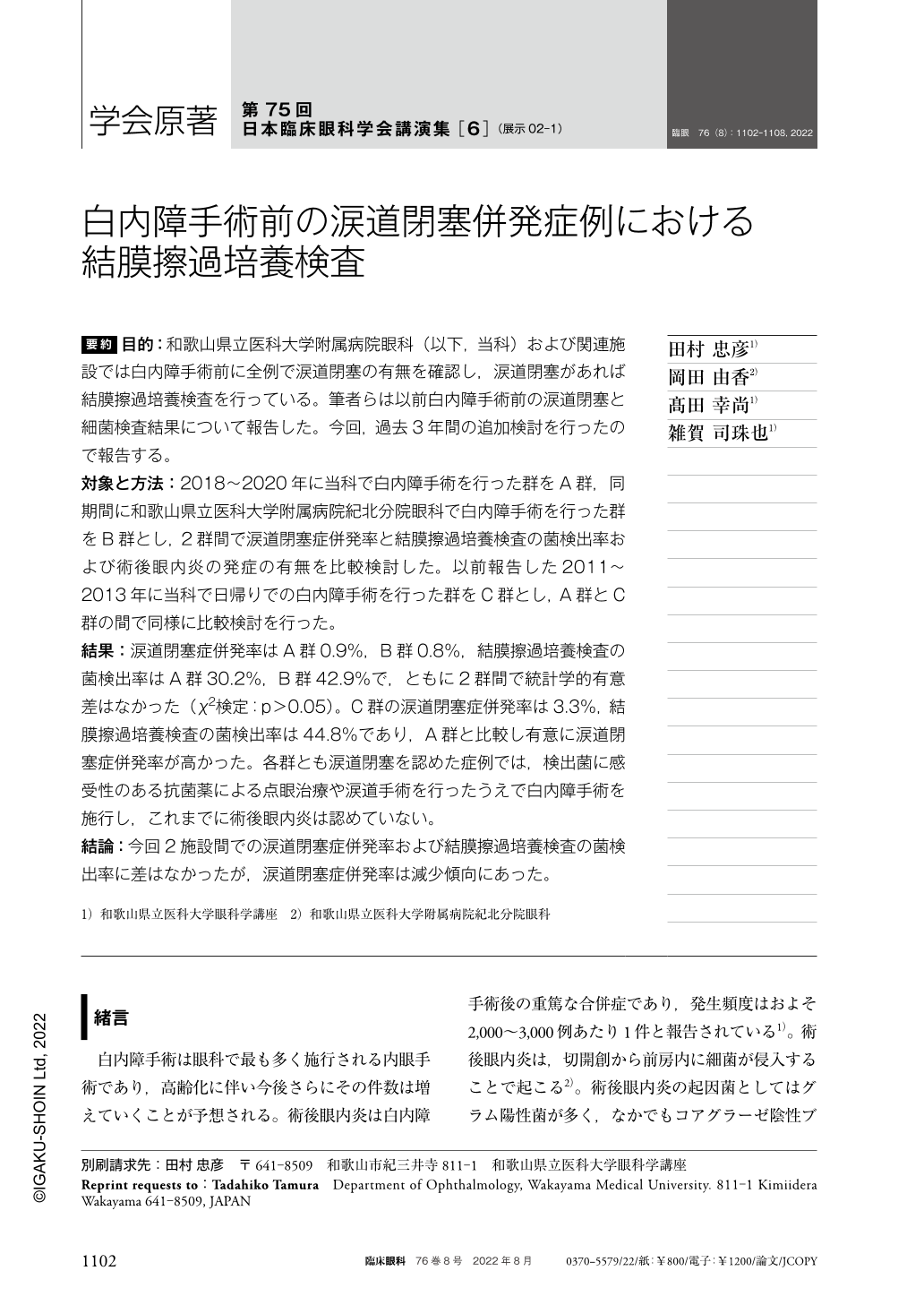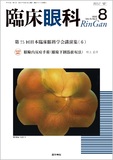Japanese
English
- 有料閲覧
- Abstract 文献概要
- 1ページ目 Look Inside
- 参考文献 Reference
要約 目的:和歌山県立医科大学附属病院眼科(以下,当科)および関連施設では白内障手術前に全例で涙道閉塞の有無を確認し,涙道閉塞があれば結膜擦過培養検査を行っている。筆者らは以前白内障手術前の涙道閉塞と細菌検査結果について報告した。今回,過去3年間の追加検討を行ったので報告する。
対象と方法:2018〜2020年に当科で白内障手術を行った群をA群,同期間に和歌山県立医科大学附属病院紀北分院眼科で白内障手術を行った群をB群とし,2群間で涙道閉塞症併発率と結膜擦過培養検査の菌検出率および術後眼内炎の発症の有無を比較検討した。以前報告した2011〜2013年に当科で日帰りでの白内障手術を行った群をC群とし,A群とC群の間で同様に比較検討を行った。
結果:涙道閉塞症併発率はA群0.9%,B群0.8%,結膜擦過培養検査の菌検出率はA群30.2%,B群42.9%で,ともに2群間で統計学的有意差はなかった(χ2検定:p>0.05)。C群の涙道閉塞症併発率は3.3%,結膜擦過培養検査の菌検出率は44.8%であり,A群と比較し有意に涙道閉塞症併発率が高かった。各群とも涙道閉塞を認めた症例では,検出菌に感受性のある抗菌薬による点眼治療や涙道手術を行ったうえで白内障手術を施行し,これまでに術後眼内炎は認めていない。
結論:今回2施設間での涙道閉塞症併発率および結膜擦過培養検査の菌検出率に差はなかったが,涙道閉塞症併発率は減少傾向にあった。
Abstract Purpose:At the Department of Ophthalmology, Wakayama Medical University Hospital, and its affiliated institutions, all patients are checked for lacrimal obstruction before cataract surgery, and if lacrimal obstruction is found, bacterial test is performed for the conjunctival swabs. We have previously reported on lacrimal obstruction and bacterial test before cataract surgery. Herein, we performed additional study for the past 3 years.
Subjects and Methods:The cataract surgery group at the Department of Ophthalmology, Wakayama Medical University Hospital during 2018-2020 was designated as Group A, and the cataract surgery group at the Department of Ophthalmology, Wakayama Medical University Kihoku Hospital during the same period was designated as Group B. We compared the incidence of lacrimal obstruction and the results of bacterial test from conjunctive swab and the incidence of postoperative endophthalmitis between the two groups. The previously reported outpatient cataract surgery group between 2011 and 2013 were designated as group C, and the same comparative study was conducted between Group A and C.
Results:The incidence of lacrimal obstruction was 0.9% in Group A and 0.8% in Group B. The detection rate of bacteria by conjunctival swab was 30.2% in Group A and 42.9% in Group B. No statistically significant difference between the two groups. The incidence of lacrimal obstruction in group C was 3.3%, which was significantly higher than that in group A, and the detection rate of bacterial test was 44.8%. In each group, patients with lacrimal obstruction underwent cataract surgery after ophthalmic treatment with antibacterial agents susceptible to the detected bacteria and lacrimal surgery. Postoperative endophthalmitis was not observed in each group.
Conclusion:Although there was no difference in the incidence of lacrimal obstruction and conjunctival abrasion culture between the two institutions, the rate of lacrimal obstruction tended to decrease.

Copyright © 2022, Igaku-Shoin Ltd. All rights reserved.


